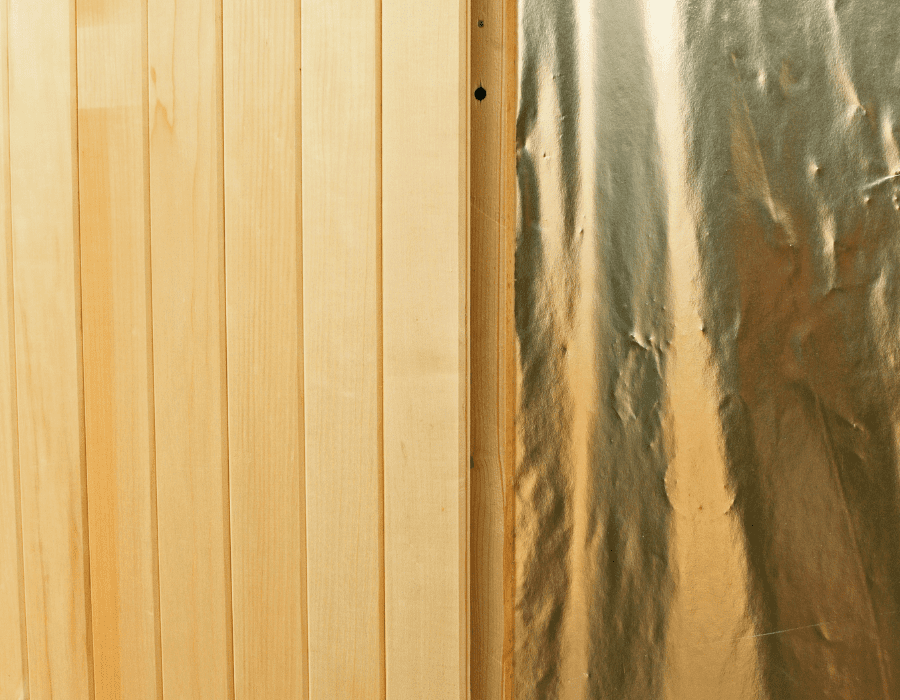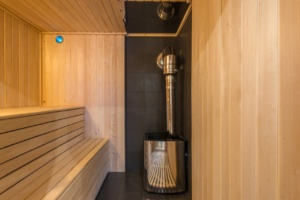

About the Author:
CEO at AlFiPa, responsible for operations as well as purchasing and sales. He is the primary contact for orders and deliveries within the company.
Vapour barrier or vapour barrier in sauna construction
When building a sauna, a vapour barrier or vapour check should be installed. But what’s the difference?
Vapour barrier and vapour check differences
With a vapour barrier, no moisture at all gets through to individual parts of the building. The vapour barrier is so tight that not even steam can escape. This provides optimum protection against moisture for the corresponding components.
With a vapour check, on the other hand, there is no 100% tightness. Water vapour can escape in small quantities. Aluminium foil is often used for a vapour barrier. It must be installed very professionally so that it is actually airtight. Otherwise it could quickly happen that the water vapour finds its way through the cracks in the aluminium foil to the brickwork during a sauna construction.
The cold store
A professional vapour barrier made of aluminium foil is particularly important in cold stores or saunas. This is a layer that is attached to the warm side of the components during sauna construction. It is therefore glued to the inside of the sauna. This prevents or at least limits water vapour diffusion. The vapour barrier ensures that there is no high moisture penetration through the insulation layer.
The diffusing water vapour is simply held off. The advantage of building a sauna is that the vapour barrier can be laid cleanly. A renovation requires considerably more work. Only high-quality aluminium foil should be used for the vapour barrier during sauna construction.
Importance of vapour barriers in sauna construction

Importance of vapour barriers in sauna construction
A sauna is usually made of wood. To prevent the wood from swelling and shrinking due to moisture, a vapour barrier should be installed. The advantage of wood in sauna construction is that it gives a sauna its typical character. In addition to its great appearance, wood is also an ideal building element because it is easy to work with. It has a low density and is usually very durable.
Unless, then, wood comes into constant contact with water vapor. Then it does not retain its natural colour for long, but discolours and swells. Such deficiencies cannot be remedied afterwards. Therefore a precaution by a vapour barrier is the better alternative. When building a sauna, you should first think about whether a vapour control layer or vapour barrier is more suitable.
A vapour barrier is well suited for the regulation of water vapour diffusion. This is particularly important when condensation water is formed by fresh air and sweat. The vapour barriers made of aluminium foil must be installed on the warmer inner side of the sauna construction during sauna construction. This prevents the formation of condensation, condensation or water vapour diffusion. Many vapour retarders for sauna construction are made of metals. Metal such as copper, aluminium, copper or corrugated sheets are considered to be particularly resistant to corrosion. When building a sauna, care must be taken that the sauna ceiling is not covered with aluminium foil. Otherwise the formation of dripping water could occur.
Does aluminium foil make sense in sauna construction?
Aluminium foil is so useful for sauna construction because it is easy to process. The aluminium foil is available in 50 to 100 m lengths. It should only be ensured that the film is laid out cleanly. More information: https://alfipa.com/applications/
Large-area gluing of the sauna is usually more effective. There must be no air holes between the individual lanes. Otherwise the water vapour will find its way to the insulation despite all precautionary measures. Before masking the aluminium foil, make sure that all walls are dry. In some building materials, there is some water.
If the film is applied before drying, the moisture of the material cannot escape.
If a sauna made of wood is covered with aluminium foil during construction, then you should be sure that the wood has dried thoroughly beforehand. Besides, you should make sure that the sauna is equipped with high-quality gaskets. A seal protects against soil moisture and water. The gasket should form a unit with an insulating layer. The floor of a sauna cabin should also be adequately protected against rising damp. Special cardboard is mostly used for this purpose. For the sides of the sauna a protective coating or a grout should be used. Only then should the vapour barrier be started.
Pros & Cons

Pros and cons of aluminium foil in sauna construction
Aluminium foil is easy to process. It is corrosion resistant and resistant. For this it is of course necessary to handle the aluminium foil carefully. If it is glued over a large area, then it usually becomes easier. The foil should be applied directly to the interior of the sauna. The ceiling should be left free.
Otherwise it could lead to the water forming on the ceiling as dripping water. This can be very unpleasant for all sauna-goers.
A small disadvantage of aluminium foil is that moisture cannot easily escape from the sauna material. If a slightly damp material is used during sauna construction, the water vapour cannot escape. The material would gradually weather. For this reason, it is particularly important that the aluminium foil is applied professionally. Of course, a vapour barrier can also be dispensed with. In this case, the material, which has become damp in winter, should dry thoroughly to avoid damage.
However, it is much better if the sauna is optimally protected during the sauna construction phase. The vapour barrier is always necessary when a high moisture load occurs. A static moisture load is the effect of moisture always entering the sauna from one side. As a rule, moisture moves from warm to cold. Accordingly, the film must always be applied to the warm side.
